16 The Newborn

Assessing the Newborn
Video offers a brief introduction to Dr. Virginia Apgar and the newborn assessment she created.
The Apgar assessment is conducted one minute and five minutes after birth. This is a very quick way to assess the newborn’s overall condition. Five measures are assessed: Heart rate, respiration, muscle tone (assessed by touching the baby’s palm), reflex response (the Babinski reflex is tested), and color. A score of 0 to 2 is given on each feature examined. An Apgar of 5 or less is cause for concern. The second Apgar should indicate improvement with a higher score.[1]
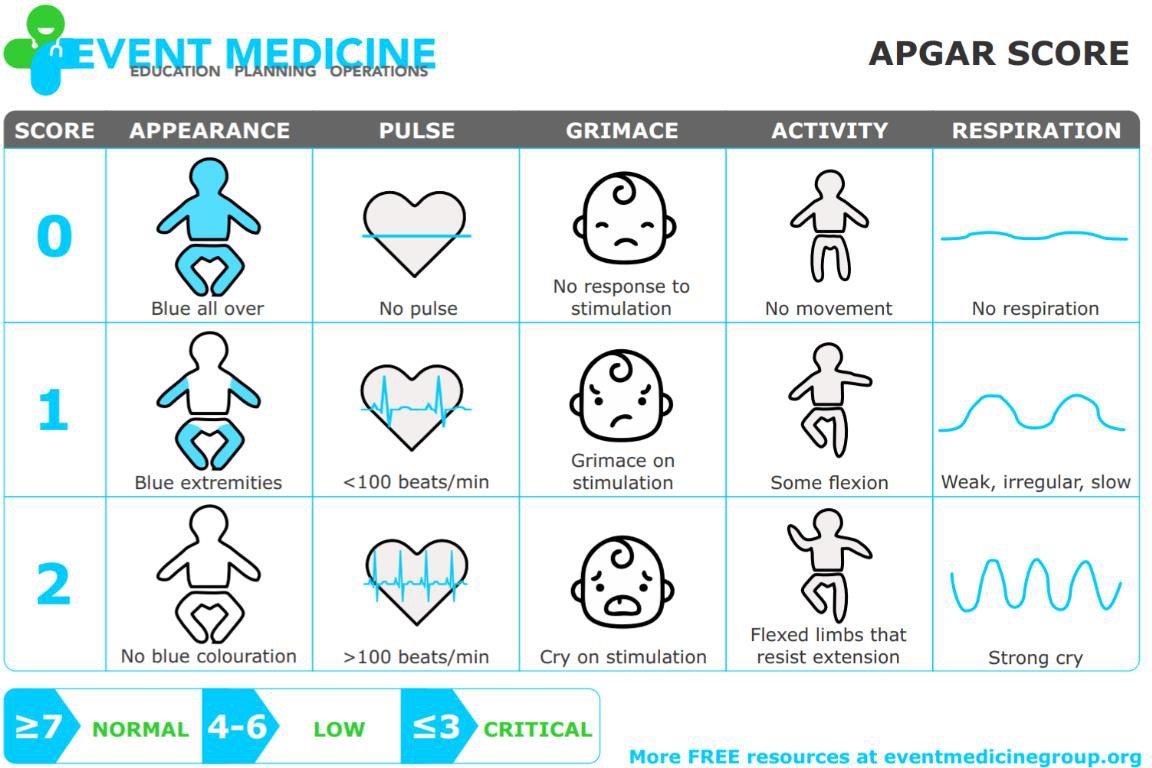
Video offers a longer explanation of the Apgar assessment for newborns.
Another way to assess the condition of the newborn is the Neonatal Behavioral Assessment Scale (NBAS). The baby’s motor development, muscle tone, and stress response are assessed. This tool has been used around the world to further assess the newborn, especially those with low Apgar scores, and to make comparisons of infants in different cultures (Brazelton & Nugent, 1995).
Newborns are also routinely screened for different conditions. Within the first 24 to 48 hours after birth, babies born in hospitals undergo a simple heel stick and a few drops of blood are collected on a special paper card. Providers test those dried blood spots for a variety of different congenital disorders, or conditions that are present when the baby is born. In California, newborns are now screened for 80 different genetic and congenital disorders.

Newborns are also screened for hearing disorders and certain serious heart problems using methods other than dried blood spots.[2]
Problems of the Newborn
In this video, Dr. Boise reviews different problems we may see, touching on risk factors and both short term and long term outcomes for some newborn problems.
Anoxia
Anoxia is a temporary lack of oxygen to the brain. Difficulty during delivery may lead to anoxia which can result in brain damage or in severe cases, death. Babies who suffer both low birth weight and anoxia are more likely to suffer learning disabilities later in life as well.
Low Birth Weight
A child is considered low birth weight if he or she weighs less than 5 pounds 8 ounces (2500 grams). About 8.2 percent of babies born in the United States are of low birth weight (Center for Disease Control, 2015a). Sixty-seven percent of these babies are also preterm.
A low birth weight baby has difficulty maintaining adequate body temperature because it lacks the fat that would otherwise provide insulation. Such a baby is also at more risk for infection. Very low birth weight babies (2 pounds or less) have an increased risk of developing cerebral palsy. Many causes of low birth weight are preventable with proper prenatal care.
Preterm
A newborn might also have a low birth weight if it is born at less than 37 weeks gestation, which qualifies it as a preterm baby (CDC, 2015c). Early birth can be triggered by anything that disrupts the mother’s system. For instance, vaginal infections can lead to premature birth because such infection causes the mother to release anti-inflammatory chemicals which, in turn, can trigger contractions. Smoking and the use of other teratogens can lead to preterm birth. A significant consequence of preterm birth includes respiratory distress syndrome, which is characterized by weak and irregular breathing (see the image below). Premature babies often cannot yet regulate their own temperature or feed by nursing or bottle. They may struggle to regulate their heart rate effectively and may experience jaundice. They often require care in the Neonatal Intensive Care Unit (NICU) until they are as healthy as a full-term baby.
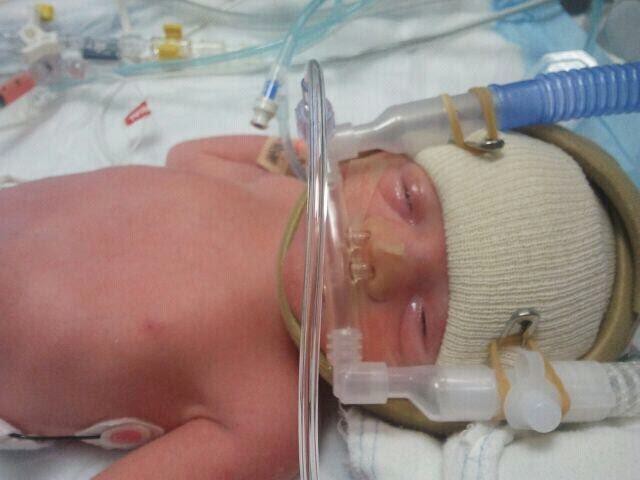
Small-for-Date Infants
Infants that have birth weights that are below expectation based on their gestational age are referred to as small-for-date. These infants may be full term or preterm (see image below), but still weigh less than 90% of all babies of the same gestational age. This is a very serious situation for newborns as their growth was adversely affected. Regev et al. (2003) found that small-for- date infants died at rates more than four times higher than other infants.
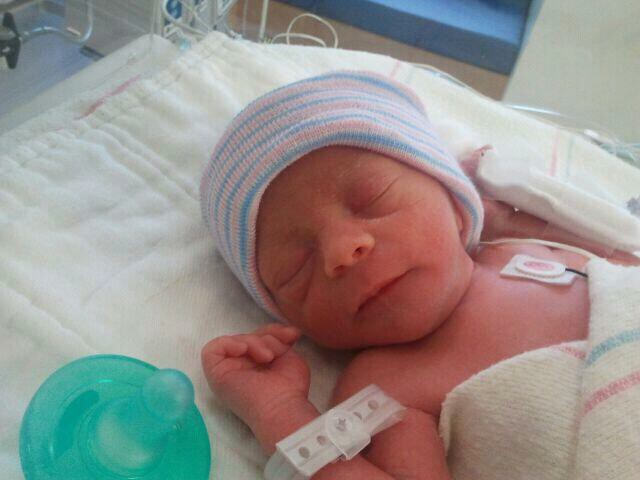
Postmature
When babies are not born by 42 weeks gestation, or two weeks after their due date, they are considered overdue or postmature. There are some concerns about how long the placenta can function and most doctors will consider induction for overdue babies.
Stillborn
When a fetus (unborn baby) dies while still inside the mother (after 20-24 weeks gestation) or dies during delivery (childbirth). It is said that the delivered baby is stillborn. The causes of many stillbirths are unknown, even when special tests are done to learn the cause. Possible causes include: nicotine, alcohol, or drugs taken by the mother during pregnancy, physical trauma, radiation poisoning, Rh disease, and umbilical cord problems. The number of stillbirths in the United States is about 1 in 115 births, which is about 26,000 a year, or one every 20 minutes.[3]
Characteristics of Newborns
In this video, Dr. Boise briefly describes characteristics such as newborn appearance and senses.
Size
The average newborn in the United States weighs about 7.5 pounds and is about 20 inches in length. For the first few days of life, infants typically lose about 5 percent of their body weight as they eliminate waste and get used to feeding. This often goes unnoticed by most parents, but can be cause for concern for those who have a smaller infant. This weight loss is temporary, however, and is followed by a rapid period of growth.
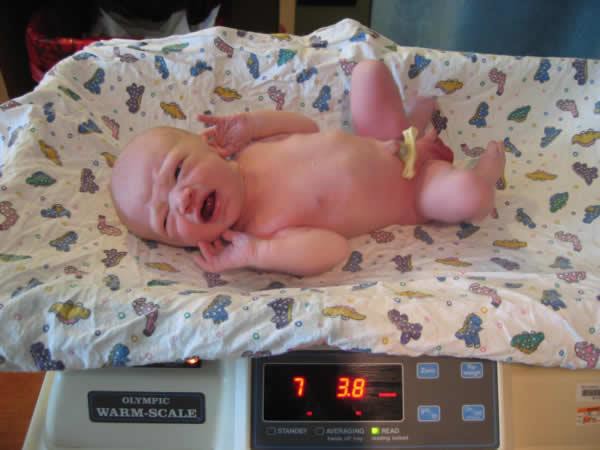
Body Proportions
The head initially makes up about 50 percent of our entire length when we are developing in the womb. At birth, the head makes up about 25 percent of our length (think about how much of your length would be head if the proportions were still the same!).

Brain Development
Some of the most dramatic physical change that occurs during this period is in the brain. At birth, the brain is about 25 percent its adult weight and this is not true for any other part of the body. While most of the brain’s 100 to 200 billion neurons are present at birth, they are not fully mature. During the next several years dendrites or connections between neurons will undergo a period of transient exuberance or temporary dramatic growth.[4]
Appearance at Birth
During labor and birth, the infant’s skull changes shape to fit through the birth canal, sometimes causing the child to be born with a misshapen or elongated head. It will usually return to normal on its own within a few days or weeks.
Some newborns have a fine, downy body hair called lanugo. It may be particularly noticeable on the back, shoulders, forehead, ears and face of premature infants. Lanugo disappears within a few weeks. Likewise, not all infants are born with lush heads of hair. Some may be nearly bald while others may have very fine, almost invisible hair. Some babies are even born with a full head of hair. Amongst fair-skinned parents, this fine hair may be blond, even if the parents are not.
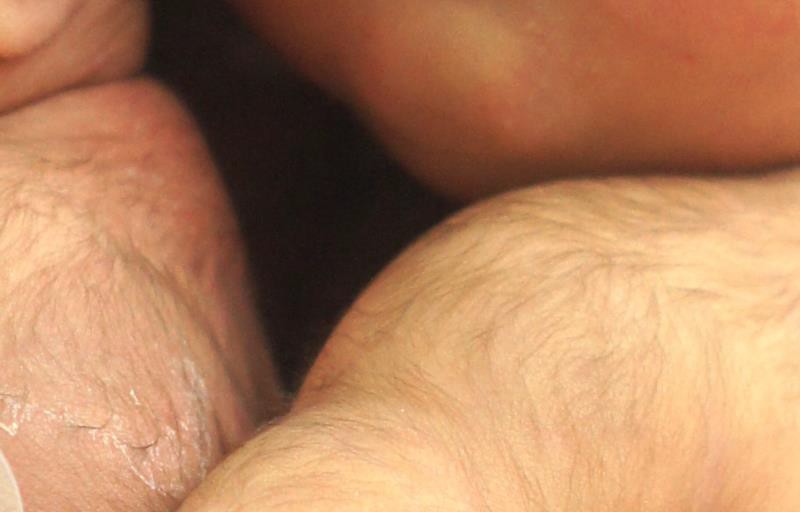
Immediately after birth, a newborn’s skin is often grayish to dusky blue in color. As soon as the newborn begins to breathe, usually within a minute or two, the skin’s color returns to its normal tone. Newborns are wet, covered in streaks of blood, and coated with a white substance known as vernix, which is thought to act as an antibacterial barrier, seen in the picture on the right.
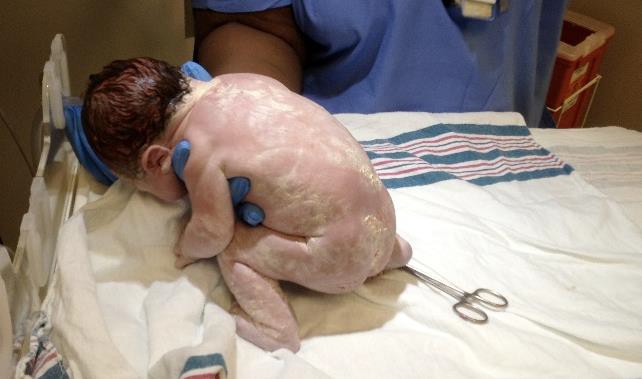
The scalp may also be temporarily bruised or swollen, especially in hairless newborns, and the area around the eyes may be puffy.
The newborn may also have Mongolian spots (blue or blue black birthmark on the lower back), various other birthmarks, or peeling skin, particularly on the wrists, hands, ankles, and feet.[5]
A newborn’s genitals are enlarged and reddened, with male infants having an unusually large scrotum. The breasts may also be enlarged, even in male infants. This is caused by naturally- occurring maternal hormones and is a temporary condition.
The umbilical cord of a newborn is bluish-white in color. After birth, the umbilical cord is normally cut, leaving a 1–2 inch stub. The umbilical stub will dry out, shrivel, darken, and spontaneously fall off within about 3 weeks. Occasionally, hospitals may apply triple dye to the umbilical stub to prevent infection, which may temporarily color the stub and surrounding skin purple.
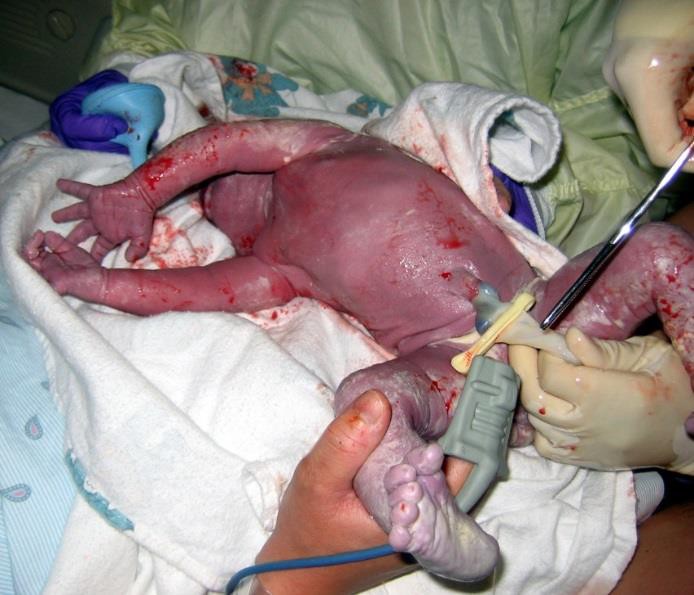
Figure 3.17 – The clamping and cutting of a newborn’s umbilical cord. Image by NNethala is licensed under CC BY-SA 3.0
Newborns lose many of the above physical characteristics quickly. Thus older babies look very different. While older babies are considered “cute,” newborns can be “unattractive” by the same criteria and first time parents may need to be educated in this regard.[6]
Sleep
A newborn typically sleeps approximately 16.5 hours per 24-hour period. The infant sleeps in several periods throughout the day and night, which means they wake often throughout the day and night. (Salkind, 2005).

Reflexes
Newborns are equipped with a number of reflexes, which are involuntary movements in response to stimulation. Some of the more common reflexes, such as the sucking reflex and rooting reflex, are important to feeding. The grasping and stepping reflexes are eventually replaced by more voluntary behaviors. Within the first few months of life these reflexes disappear, while other reflexes, such as the eye-blink, swallowing, sneezing, gagging, and withdrawal reflex stay with us as they continue to serve important functions.
Sensory Capacities
Throughout much of history, the newborn was considered a passive, disorganized being who possessed minimal abilities. However, current research techniques have demonstrated just how developed the newborn is with especially organized sensory and perceptual abilities.
Vision
The womb is a dark environment void of visual stimulation. Consequently, vision is the most poorly developed sense at birth and time is needed to build those neural pathways between the eye and the brain. You will learn more about early development of vision in the next chapter.
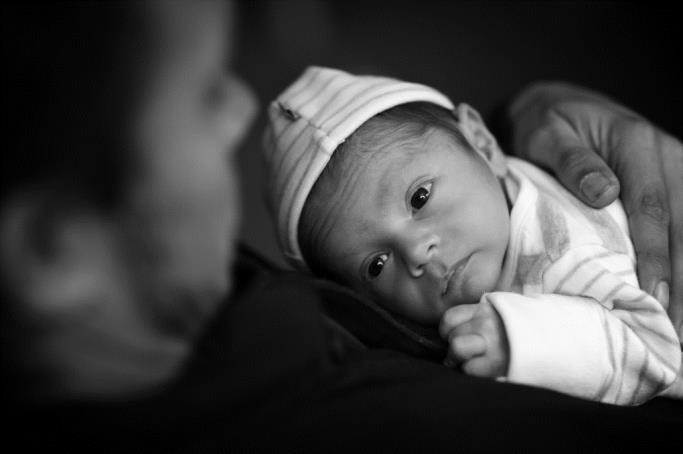
Hearing
The infant’s sense of hearing is very keen at birth, and the ability to hear is evidenced as soon as the 7th month of prenatal development. In fact, an infant can distinguish between very similar sounds as early as one month after birth and can distinguish between a familiar and unfamiliar voice even earlier. Additionally, they will register in utero specific information heard from their mother’s voice.
Touch and Pain
Immediately after birth, a newborn is sensitive to touch and temperature, and is also highly sensitive to pain, responding with crying and cardiovascular responses (Balaban & Reisenauer, 2013).
Taste and Smell
Studies of taste and smell demonstrate that babies respond with different facial expressions, suggesting that certain preferences are innate. Newborns can distinguish between sour, bitter, sweet, and salty flavors and show a preference for sweet flavors. Newborns also prefer the smell of their mothers. An infant only 6 days old is significantly more likely to turn toward its own mother’s breast pad than to the breast pad of another baby’s mother (Porter, Makin, Davis, & Christensen, 1992), and within hours of birth an infant also shows a preference for the face of its own mother (Bushnell, 2001; Bushnell, Sai, & Mullin, 1989).[7]
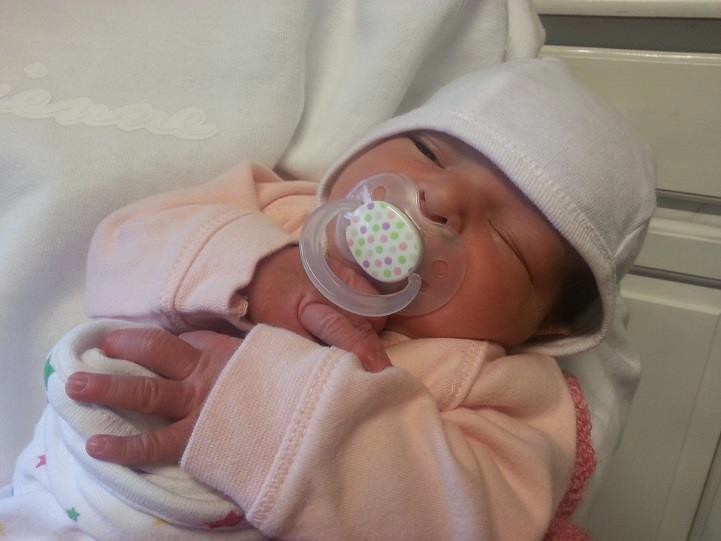
- Lifespan Development: A Psychological Perspective by Martha Lally and Suzanne Valentine-French is licensed under CC BY-NC-SA 3.0 ↵
- Newborn Screening is in the public domain. Newborn Screening Program (NBS) by the California Department of Public Health is in the public domain ↵
- Lifespan Development: A Psychological Perspective by Martha Lally and Suzanne Valentine-French is licensed under CC BY-NC-SA 3.0. Stillbirth by Wikipedia by Wikipedia is licensed under CC BY-SA 3.0 ↵
- Lifespan Development - Chapter 4: Infancy - Physical Development by Lumen Learning references Psyc 200 Lifespan Psychology by Laura Overstreet, licensed under CC BY 4.0 ↵
- Mongolian Spot by Wiktionary is licensed under CC BY-SA 3.0 ↵
- Infant by WikiDoc is licensed under CC BY-SA 3.0 (sections modified by Courtney Boise) ↵
- Lifespan Development: A Psychological Perspective by Martha Lally and Suzanne Valentine-French is licensed under CC BY-NC-SA 3.0 ↵

